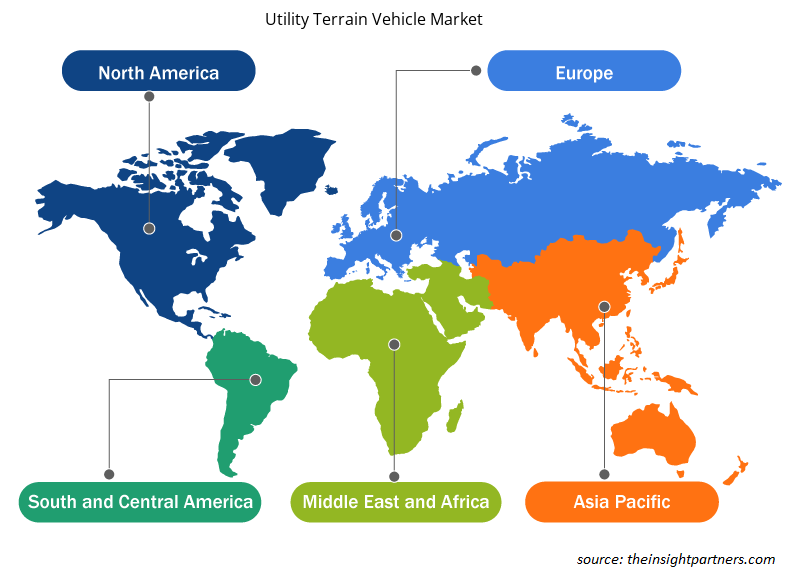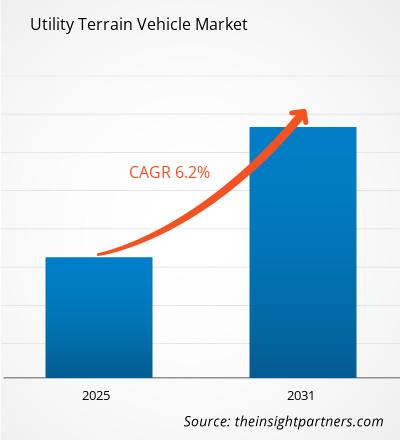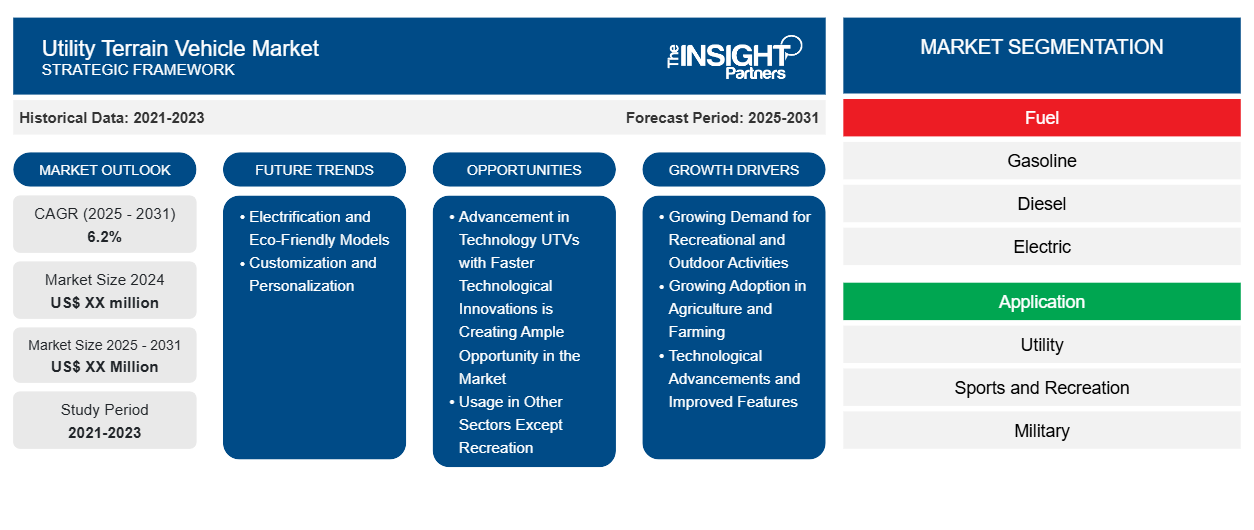Se espera que el mercado de vehículos todoterreno utilitarios registre una CAGR del 6,2 % entre 2023 y 2031, con un tamaño de mercado que se expandirá de US$ XX millones en 2023 a US$ XX millones en 2031.
El mercado de vehículos utilitarios todoterreno cubre el análisis por combustible (gasolina, diésel y eléctrico), aplicación (utilitario, deportivo y recreativo, militar); capacidad de asientos (2, 4, 6); tipo (transporte de personas y transporte de mercancías); tipo de tracción (tracción en dos ruedas, tracción en las cuatro ruedas y tracción en las seis ruedas) y geografía.
Propósito del Informe
El informe Utility Terrain Vehicle Market de The Insight Partners tiene como objetivo describir el panorama actual y el crecimiento futuro, los principales factores impulsores, los desafíos y las oportunidades. Esto proporcionará información a diversas partes interesadas del negocio, como:
- Proveedores/fabricantes de tecnología: Para comprender la dinámica cambiante del mercado y conocer las oportunidades potenciales de crecimiento, lo que les permitirá tomar decisiones estratégicas informadas.
- Inversionistas: Realizar un análisis exhaustivo de tendencias sobre la tasa de crecimiento del mercado, las proyecciones financieras del mercado y las oportunidades que existen en toda la cadena de valor.
- Órganos reguladores: Regular las políticas y vigilar las actividades del mercado con el objetivo de minimizar los abusos, preservar la confianza de los inversores y defender la integridad y la estabilidad del mercado.
Segmentación del mercado de vehículos todoterreno utilitarios
Combustible
- Gasolina
- Diesel
- Eléctrico
Solicitud
- Utilidad
- Deportes y recreación
- Militar
Capacidad de asientos
- 2
- 4
- 6
Tipo
- Transporte de personas
- Transportista de mercancías
Tipo
- Transporte de personas
- Transportista de mercancías
Personalice este informe según sus necesidades
Obtendrá personalización en cualquier informe, sin cargo, incluidas partes de este informe o análisis a nivel de país, paquete de datos de Excel, así como también grandes ofertas y descuentos para empresas emergentes y universidades.
-
Obtenga las principales tendencias clave del mercado de este informe.Esta muestra GRATUITA incluirá análisis de datos, desde tendencias del mercado hasta estimaciones y pronósticos.
Factores impulsores del crecimiento del mercado de vehículos todoterreno utilitarios
- Demanda creciente de actividades recreativas y al aire libre: a medida que más personas se interesan por las actividades recreativas al aire libre y los deportes de aventura, existe una creciente demanda de UTV. Estos vehículos todoterreno permiten a los entusiastas llegar a áreas a las que la mayoría de los demás vehículos no pueden acceder, lo que los hace cada vez más populares para la caza, la acampada y las carreras todoterreno. Además, el creciente número de eventos y deportes al aire libre, como las carreras todoterreno, también está contribuyendo a la creciente demanda de UTV.
- Adopción creciente en la agricultura y la ganadería: los UTV están ganando popularidad en el sector agrícola debido a su versatilidad y capacidad para acceder a áreas de cultivo de difícil acceso. Los vehículos se utilizan para transportar equipos, herramientas, fertilizantes e incluso cultivos en terrenos difíciles. Con la creciente demanda de equipos agrícolas eficientes y la necesidad de dispositivos que ahorren mano de obra, los UTV se están convirtiendo rápidamente en una herramienta esencial para la agricultura moderna.
- Avances tecnológicos y características mejoradas: la innovación constante en el diseño y la tecnología de los UTV es un importante impulsor del crecimiento del mercado. Características como mejores sistemas de suspensión, medidas de seguridad mejoradas, motores más potentes y sistemas avanzados de información y entretenimiento están haciendo que los UTV sean más atractivos para los consumidores. Los fabricantes también están integrando sistemas de propulsión eléctricos, funciones autónomas y conectividad más inteligente, para satisfacer las necesidades de un público más amplio, desde usuarios recreativos hasta operadores comerciales.
Tendencias futuras del mercado de vehículos todoterreno utilitarios
-
Electrificación y modelos ecológicos: los UTV eléctricos se han convertido en uno de los productos más elegidos por los consumidores y las empresas que ahora prestan atención a ser más ecológicas. De hecho, estos UTV eléctricos son silenciosos, no producen emisiones y cuestan menos de mantener que los que tienen motores de gasolina. La creciente demanda de productos "ecológicos" obliga a los fabricantes a desarrollar modelos de UTV eléctricos o híbridos, especialmente en regiones que tienen estrictas regulaciones ambientales.
Muchos consumidores de UTV están en busca de necesidades específicas, que pueden estar más enfocadas a la recreación o a fines utilitarios. - Personalización y personalización: Por lo tanto, los fabricantes están cada vez más abiertos a ofrecer a los usuarios opciones de características personalizables, como mejorar la suspensión, ajustar los asientos, personalizar el almacenamiento y diferentes tipos de kits de carrocería. La demanda de los consumidores se ha orientado a personalizar sus vehículos de una manera que se adapte a su tipo de terreno, utilidad o preferencia estética.
Oportunidades de mercado para vehículos todoterreno utilitarios
- El avance de la tecnología de los UTV con innovaciones tecnológicas más rápidas está creando una amplia oportunidad en el mercado: el creciente desarrollo de vehículos utilitarios todoterreno basados en características avanzadas está creando una amplia oportunidad en el mercado. Las características avanzadas incluyen mayor seguridad, mejores métricas de rendimiento y opciones de conectividad más avanzadas. Todas estas innovaciones están haciendo que los UTV sean más atractivos para un público más amplio, que abarca desde usuarios recreativos hasta operadores comerciales.
- Uso en otros sectores, excepto el recreativo: el mercado de vehículos utilitarios todo terreno está pasando del sector tradicional del ocio a otros sectores, como la construcción, la minería, la silvicultura y los servicios de emergencia. Los vehículos utilitarios todo terreno se utilizan para el transporte de mercancías, la inspección y el mantenimiento de servicios públicos en lugares inaccesibles. En estos usos comerciales e industriales, los fabricantes de vehículos utilitarios todo terreno llegarán a una base de clientes más amplia y encontrarán nuevas fuentes de ingresos. La demanda de vehículos utilitarios todo terreno con características especializadas adaptadas a industrias específicas, como la capacidad de remolque, las capacidades todoterreno o las características de seguridad, ofrece una enorme oportunidad de crecimiento.
Perspectivas regionales del mercado de vehículos todoterreno utilitarios
Los analistas de Insight Partners explicaron en detalle las tendencias y los factores regionales que influyen en el mercado de vehículos todoterreno utilitarios durante el período de pronóstico. Esta sección también analiza los segmentos y la geografía del mercado de vehículos todoterreno utilitarios en América del Norte, Europa, Asia Pacífico, Oriente Medio y África, y América del Sur y Central.

- Obtenga datos regionales específicos para el mercado de vehículos todoterreno utilitarios
Alcance del informe de mercado de vehículos todoterreno utilitarios
| Atributo del informe | Detalles |
|---|---|
| Tamaño del mercado en 2023 | XX millones de dólares estadounidenses |
| Tamaño del mercado en 2031 | US$ XX millones |
| CAGR global (2023 - 2031) | 6,2% |
| Datos históricos | 2021-2022 |
| Período de pronóstico | 2024-2031 |
| Segmentos cubiertos |
Por combustible
|
| Regiones y países cubiertos |
América del norte
|
| Líderes del mercado y perfiles de empresas clave |
|
Densidad de actores del mercado de vehículos todoterreno utilitarios: comprensión de su impacto en la dinámica empresarial
El mercado de vehículos todoterreno utilitarios está creciendo rápidamente, impulsado por la creciente demanda de los usuarios finales debido a factores como la evolución de las preferencias de los consumidores, los avances tecnológicos y una mayor conciencia de los beneficios del producto. A medida que aumenta la demanda, las empresas amplían sus ofertas, innovan para satisfacer las necesidades de los consumidores y aprovechan las tendencias emergentes, lo que impulsa aún más el crecimiento del mercado.
La densidad de actores del mercado se refiere a la distribución de las empresas o firmas que operan dentro de un mercado o industria en particular. Indica cuántos competidores (actores del mercado) están presentes en un espacio de mercado determinado en relación con su tamaño o valor total de mercado.
Las principales empresas que operan en el mercado de vehículos todoterreno utilitarios son:
- Deere & Company
- Compañía: Hisun Motors Corp. Limitada.
- Compañía de motores Honda, Ltd.
- Corporación Kubota
- Industrias Polaris, Inc.
- Corporación Suzuki Motor
Descargo de responsabilidad : Las empresas enumeradas anteriormente no están clasificadas en ningún orden particular.

- Obtenga una descripción general de los principales actores clave del mercado de vehículos todoterreno utilitarios
Puntos de venta clave
- Cobertura integral: el informe cubre de manera integral el análisis de productos, servicios, tipos y usuarios finales del mercado de vehículos utilitarios todoterreno, proporcionando un panorama holístico.
- Análisis de expertos: el informe se compila sobre la base de un profundo conocimiento de expertos y analistas de la industria.
- Información actualizada: El informe asegura relevancia comercial debido a su cobertura de información reciente y tendencias de datos.
- Opciones de personalización: este informe se puede personalizar para satisfacer los requisitos específicos del cliente y adaptarse adecuadamente a las estrategias comerciales.
Por lo tanto, el informe de investigación sobre el mercado de vehículos todoterreno utilitarios puede ayudar a abrir camino para descifrar y comprender el escenario de la industria y las perspectivas de crecimiento. Si bien puede haber algunas preocupaciones válidas, los beneficios generales de este informe tienden a superar las desventajas.
- Análisis histórico (2 años), año base, pronóstico (7 años) con CAGR
- Análisis PEST y FODA
- Tamaño del mercado, valor/volumen: global, regional y nacional
- Industria y panorama competitivo
- Conjunto de datos de Excel
Informes recientes
Testimonios
Razón para comprar
- Toma de decisiones informada
- Comprensión de la dinámica del mercado
- Análisis competitivo
- Información sobre clientes
- Pronósticos del mercado
- Mitigación de riesgos
- Planificación estratégica
- Justificación de la inversión
- Identificación de mercados emergentes
- Mejora de las estrategias de marketing
- Impulso de la eficiencia operativa
- Alineación con las tendencias regulatorias























 Obtenga una muestra gratuita para - Mercado de vehículos todoterreno utilitarios
Obtenga una muestra gratuita para - Mercado de vehículos todoterreno utilitarios